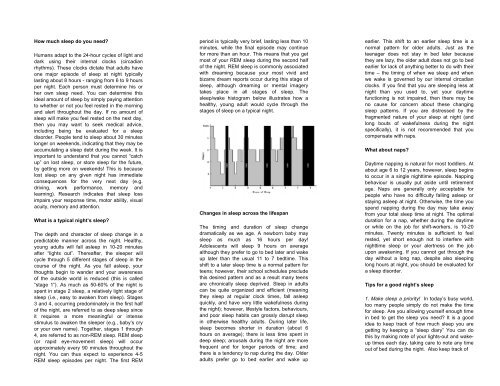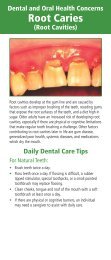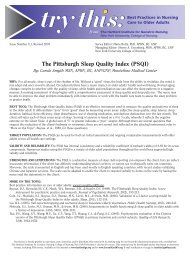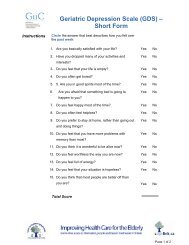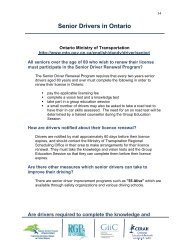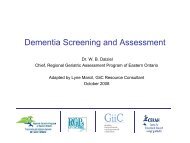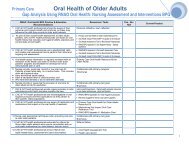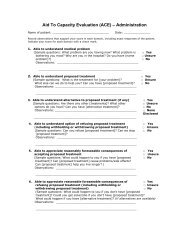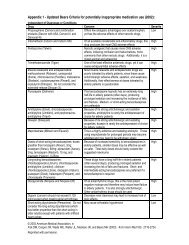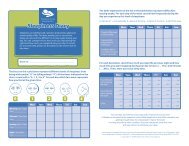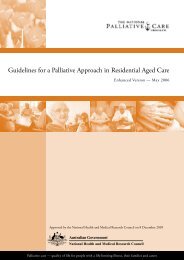Normal Sleep and Sleep Hygiene - Canadian Sleep Society
Normal Sleep and Sleep Hygiene - Canadian Sleep Society
Normal Sleep and Sleep Hygiene - Canadian Sleep Society
- TAGS
- hygiene
- www.yumpu.com
Create successful ePaper yourself
Turn your PDF publications into a flip-book with our unique Google optimized e-Paper software.
How much sleep do you need?Humans adapt to the 24-hour cycles of light <strong>and</strong>dark using their internal clocks (circadianrhythms). These clocks dictate that adults haveone major episode of sleep at night typicallylasting about 8 hours - ranging from 6 to 9 hoursper night. Each person must determine his orher own sleep need. You can determine thisideal amount of sleep by simply paying attentionto whether or not you feel rested in the morning<strong>and</strong> alert throughout the day. If no amount ofsleep will make you feel rested on the next day,then you may want to seek medical advice,including being be evaluated for a sleepdisorder. People tend to sleep about 30 minuteslonger on weekends, indicating that they may beaccumulating a sleep debt during the week. It isimportant to underst<strong>and</strong> that you cannot “catchup” on lost sleep, or store sleep for the future,by getting more on weekends! This is becauselost sleep on any given night has immediateconsequences for the very next day (e.g.driving, work performance, memory <strong>and</strong>learning). Research indicates that sleep lossimpairs your response time, motor ability, visualacuity, memory <strong>and</strong> attention.What is a typical night’s sleep?The depth <strong>and</strong> character of sleep change in apredictable manner across the night. Healthy,young adults will fall asleep in 10-20 minutesafter “lights out”. Thereafter, the sleeper willcycle through 5 different stages of sleep in thecourse of the night. As you fall asleep, yourthoughts begin to w<strong>and</strong>er <strong>and</strong> your awarenessof the outside world is reduced (this is called“stage 1”). As much as 50-60% of the night isspent in stage 2 sleep, a relatively light stage ofsleep (i.e., easy to awaken from sleep). Stages3 <strong>and</strong> 4, occurring predominately in the first halfof the night, are referred to as deep sleep sinceit requires a more meaningful or intensestimulus to awaken the sleeper (e.g., baby’s cryor your own name). Together, stages 1 through4, are referred to as non-REM sleep. REM sleep(or rapid eye-movement sleep) will occurapproximately every 90 minutes throughout thenight. You can thus expect to experience 4-5REM sleep episodes per night. The first REMperiod is typically very brief, lasting less than 10minutes, while the final episode may continuefor more than an hour. This means that you getmost of your REM sleep during the second halfof the night. REM sleep is commonly associatedwith dreaming because your most vivid <strong>and</strong>bizarre dream reports occur during this stage ofsleep, although dreaming or mental imagerytakes place in all stages of sleep. Thesleep/wake histogram below illustrates how ahealthy, young adult would cycle through thestages of sleep on a typical night.Changes in sleep across the lifespanThe timing <strong>and</strong> duration of sleep changedramatically as we age. A newborn baby maysleep as much as 16 hours per day!Adolescents will sleep 9 hours on averagealthough they prefer to go to bed later <strong>and</strong> wakeup later than the usual 11 to 7 bedtime. Thisshift to a later sleep time is a normal pattern forteens; however, their school schedules precludethis desired pattern <strong>and</strong> as a result many teensare chronically sleep deprived. <strong>Sleep</strong> in adultscan be quite organized <strong>and</strong> efficient (meaningthey sleep at regular clock times, fall asleepquickly, <strong>and</strong> have very little wakefulness duringthe night); however, lifestyle factors, behaviours,<strong>and</strong> poor sleep habits can grossly disrupt sleepin otherwise healthy adults. During later life,sleep becomes shorter in duration (about 6hours on average); there is less time spent indeep sleep; arousals during the night are morefrequent <strong>and</strong> for longer periods of time; <strong>and</strong>there is a tendency to nap during the day. Olderadults prefer go to bed earlier <strong>and</strong> wake upearlier. This shift to an earlier sleep time is anormal pattern for older adults. Just as theteenager does not stay in bed later becausethey are lazy, the older adult does not go to bedearlier for lack of anything better to do with theirtime – the timing of when we sleep <strong>and</strong> whenwe wake is governed by our internal circadianclocks. If you find that you are sleeping less atnight than you used to, yet your daytimefunctioning is not impaired, then there may beno cause for concern about these changingsleep patterns. If you are distressed by thefragmented nature of your sleep at night (<strong>and</strong>long bouts of wakefulness during the nightspecifically), it is not recommended that youcompensate with naps.What about naps?Daytime napping is natural for most toddlers. Atabout age 6 to 12 years, however, sleep beginsto occur in a single nighttime episode. Nappingbehaviour is usually put aside until retirementage. Naps are generally only acceptable forpeople who have no difficulty falling asleep orstaying asleep at night. Otherwise, the time youspend napping during the day may take awayfrom your total sleep time at night. The optimalduration for a nap, whether during the daytimeor while on the job for shift-workers, is 10-20minutes. Twenty minutes is sufficient to feelrested, yet short enough not to interfere withnighttime sleep or your alertness on the jobupon awakening. If you cannot get through theday without a long nap, despite also sleepinglong hours at night, you should be evaluated fora sleep disorder.Tips for a good night’s sleep1. Make sleep a priority! In today’s busy world,too many people simply do not make the timefor sleep. Are you allowing yourself enough timein bed to get the sleep you need? It is a goodidea to keep track of how much sleep you aregetting by keeping a “sleep diary” You can dothis by making note of your lights-out <strong>and</strong> wakeuptimes each day, taking care to note any timeout of bed during the night. Also keep track of


